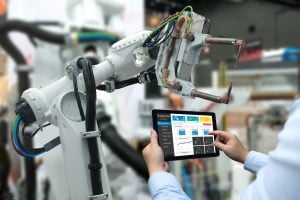Before you start planning your smart manufacturing strategy, it’s critical to identify where your business currently is in its digital transformation journey. As we briefly discussed in a recent post, the path to smart manufacturing can be broken down into four different levels.
Let’s unpack those four levels in more detail, so that you can determine where you are now and what you need to focus on next.
Level One: The Unconnected Factory
A factory operating at level one does not have a central database. Data that is generated on the factory floor via various sensors, machines and systems is held separately in different locations.
A level one factory might use technology to improve efficiency and productivity, but since there is no central database, it is difficult for decision makers to get a clear overview of the operation and develop new strategies for evolving processes.
Arguably, this unconnected way of working describes the experience of most manufacturers today, so if your operation fits this description, you’re not alone.
At level one, the challenge for CIOs and the C-suite is to understand the objectives of their future digital transformation and work with partners to plot a path forward. Our recent post on the path to smart manufacturing covers this in more detail.
Level Two: The Connected Factory
In the connected factory, sensors, machines and systems are linked to a central database, and may include solutions in a cloud or hybrid environment. At this level, decision makers can work in a more collaborative and cohesive way, accessing data from one single source of truth. Potential benefits can be seen in multiple areas of the manufacturing process, including innovation, supply chain management and problem solving, as well as logistics, sales and planning.
Collecting enough of the right data is key at this stage. Organizations need to have a clear vision of what they want to achieve in the long term, because long-term goals determine which data-sets are collected at level two.
Level Three: The Predictive Factory
Level three describes a factory that uses data-led insights, Machine Learning and Artificial Intelligence (AI) to identify where efficiencies can be made. Working at this level, decision makers have access to data-driven AI recommendations and can solve problems and identify opportunities rapidly. Very often, predictive maintenance and quality are the first areas of focus when transforming from level two to level three.
In a predictive factory, manufacturers can identify their ‘Golden Run’, when AI and Machine Learning use data to identify the very best way to make a product to the manufacturer’s specified quality.
Level Four: The Automated Factory
At the very top level of Industry 4.0, manufacturers enjoy all the functionality of a level three environment with the added benefit of automation. Here, AI and Machine Learning will identify opportunities, generate new settings and send them out to devices on the factory floor in order to implement changes. The automated system can then keep track of the changes, creating and implementing further efficiencies when necessary.
Decision makers in an automated factory can rest assured that their products are being created in the most efficient way possible.
So, where are you?
When entering the smart manufacturing space, it’s all too easy to become lost in the jargon, but the truth is that smart manufacturing technologies are all related to data and how it can be used. Using the four levels to benchmark where your factory is currently operating at allows you to visualize the next step of your journey and the technologies involved.
If you’d like to read our comprehensive guide to smart manufacturing, download our Digital Transformation Manual.
Request a demo to see how we’ve helped several customers get to a predictive factory.

